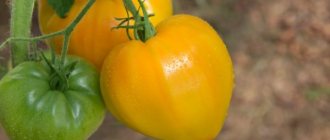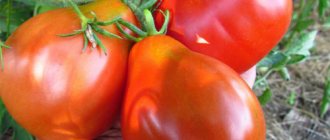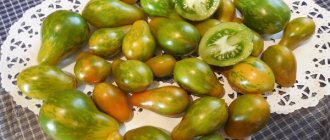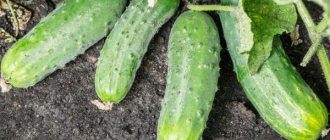Key Features
The characteristics and description of the Black Moor tomato variety are as follows:
- semi-determinate type of bush;
- mid-season ripening;
- after the sprouts appear, the tomatoes are harvested after 115-125 days;
- bush height – up to 1 m, in a greenhouse reaches 1.5 m;
- the first brush is formed after the 8th sheet, the rest - after the next 3 sheets.
The description of Black Moor tomatoes is as follows:
- fruit weight – 50 g;
- dark red tint;
- thick skin;
- elongated shape;
- fleshy and juicy pulp;
- sweet taste.
Boarding order
The Black Moor variety is recommended for growing in greenhouses and greenhouses. If climatic conditions permit, you can plant it in an open area. Regardless of the planting method, you first need to obtain seedlings, during the growth of which the necessary conditions are provided.
Obtaining seedlings
Tomato seeds begin to be planted in mid-February. About 2 months should pass before the seedlings are transferred to a permanent location.
First, prepare the soil for planting, which includes two main components: garden soil and humus. It can be prepared in the fall or purchased soil mixture in specialized stores.
If soil from the site is used, then it needs to be heated well in the oven or watered with a solution of potassium permanganate. This will eliminate harmful spores and insect larvae.
Advice! Healthy tomato seedlings are obtained by planting seeds in a coconut substrate or a mixture of peat and sand.
Then they begin to process the seed material. It must be wrapped in a damp cloth for a day. Seeds are kept at temperatures above 25 degrees, which stimulates their germination.
The containers are filled with prepared soil. For tomato seedlings, boxes or cups 15 cm high are suitable. The seeds are deepened into the soil 1 cm. The optimal spacing for planting tomato seeds is 2 cm.
Shoots appear most quickly when the ambient temperature reaches 25-30 degrees. At first, the containers are kept in a dark place, but the tomato sprouts that appear must be transferred to the light.
For half a day, tomato seedlings need lighting. It is periodically sprayed with warm water to prevent the soil from drying out.
Planting in a greenhouse
The Black Moor variety is intended for cultivation in protected ground. The heifer or greenhouse for planting tomatoes begins to be prepared in the fall. It is recommended to remove the top soil layer, since disease spores and pest larvae are concentrated in it.
The remaining soil is dug up and garden soil is added. Be sure to add compost and wood ash. Of the mineral fertilizers at this stage, superphosphate (5 spoons per 1 m2) and potassium sulfate (1 spoon) are used.
Important! Every year the place for planting tomatoes is changed.
According to the description, Black Moor tomatoes are considered tall, so they are placed in the greenhouse in increments of 40 cm. 70 cm should be left between plants. The seedlings are moved into the depressions along with a ball of earth. The roots of the tomatoes should be sprinkled with soil, compacted a little and watered generously.
Over the next 10 days, the tomatoes are not watered or fertilized. Plants need time to get used to new conditions.
Transfer to beds
In the southern regions, the Black Moor tomato is planted in open ground. In this case, select well-lit areas located on a hill. If necessary, install high beds for tomatoes.
Tomatoes prefer areas where cabbage, legumes, onions, garlic, carrots and other root vegetables previously grew. It is better to leave the beds where tomatoes, peppers, eggplants and potatoes were grown a year earlier for other crops.
Advice! The soil for tomatoes is dug up and fertilized with compost.
Tomatoes are planted in rows, with 0.7 m between them. Plants should be placed with a gap of 0.4 m. After planting, the tomatoes should be watered well.
Growing seedlings yourself
An important stage in the beginning of the dacha cycle are activities related to seedlings. Their correct implementation will ensure plant growth and protection from diseases.
Sowing time
The most optimal time to start working with seedlings is March. In the first week, work begins on preparing the seeds, so that by the middle of the month they are placed in the ground.
Important! In a greenhouse, seedlings grow faster, and therefore greenhouse planting is carried out in early April.
The seedlings are moved to a permanent location in late April - early May, depending on when the frosts end.
Soil for seedlings can be taken from the garden or purchased at the store. An alternative is to make your own soil. To do this, turf, peat and sand are mixed in equal proportions.
Initially, the seedlings are planted in boxes with soil and covered with film to retain heat in it. After the first leaves appear, it becomes necessary to provide each plant with sufficient space to grow.
In this regard, a pick is made and each plant receives a separate pot or plastic cup. Both before and after picking, soil collected from the garden and soil created with your own hands can be used.
We invite you to familiarize yourself with: Gooseberry Grushenka: description of the variety with characteristics and reviews, features of planting and cultivation and care, photos
Seed preparation
The procedure is no different from preparing seeds of other varieties. The seeds ripen for 2 weeks in a well-lit place, after which they are placed in a jar for 3 days.
Then they are washed with water and potassium permanganate and all seeds that float are removed as unsuitable. After this, they are placed in Ecosil or Epin-Extra for feeding and sown in the ground.
All articles
Sowing seeds
Sowing occurs according to the 30×40 pattern. When placing seeds in the ground, the depth of the hole is no more than 2 cm - otherwise the roots may get frostbite.
Seedling care
The temperature range is 20 °C and above, up to 25 °C. Watering is carried out as the soil dries out. They should be positioned in such a way that the plants are not exposed to direct sunlight, but at the same time the daylight hours are at least 8 hours. Fertilizing should be done once a month during watering.
Hardening is carried out 7 days before planting in a permanent place. When hardening, containers with plants are taken outside for several hours during the day, and in the evening they are brought back into the house.
Variety care
With constant care, the Black Moor variety produces a large harvest. Plants need timely watering and fertilizing. The soil under the tomatoes must be loosened and a crust must not be allowed to form.
Caring for tomatoes also includes the formation of a bush, which makes it possible to control the density of plantings. Be sure to tie the plants to a support.
According to reviews, the Black Moor tomato has average resistance to diseases. Avoiding the development of diseases will help by observing the microclimate when growing tomatoes and preventive spraying with Barrier or Fitosporin.
Watering tomatoes
The intensity of watering tomatoes depends on the stage of their development. Before the ovaries appear, the plantings are watered once a week, the moisture consumption is up to 5 liters. A lack of water is indicated by yellowing and curling of the tops, so water is added regularly.
When the first fruits appear, the tomatoes are watered twice a week. 3 liters of water are added under the bush. This scheme avoids cracking of the fruit.
Advice! After watering, the greenhouse with tomatoes is ventilated to prevent an increase in humidity.
Water is first collected in barrels. You can only use warm water that has had time to settle. The procedure is carried out in the morning or evening hours.
Feeding scheme
During the season, the Black Moor tomato requires several feedings. After planting, the plants are fertilized with phosphorus and potassium. Phosphorus improves the growth of tomatoes, and potassium improves the taste of the fruit.
Important! Take 35 g of superphosphate and potassium sulfide per large bucket of water.
Substances are introduced into the soil through watering. Such treatments are carried out no more often than once every 14 days.
During the ripening period of tomatoes, prepare a solution containing 10 liters of water, a tablespoon of sodium humate and double superphosphate. It is also added to the soil when watering tomatoes.
Ash containing calcium, potassium, magnesium and other components will help replace minerals. It is embedded directly into the soil or infused in a bucket of water, after which the tomatoes are watered.
Bush formation
The Black Moor variety is formed into one or two stems. Excess shoots from tomatoes must be eliminated. They are broken off by hand until their length is 5 cm.
The formation of a bush is necessary to increase the yield of tomatoes. The procedure does not promote the growth of green mass of tomatoes, which has a positive effect on the microclimate in the greenhouse and fruit formation.
Since, according to the description, the Black Moor tomato is tall, it is tedious to tie it to a support. This way the straight stem of the plant is formed, and the fruits do not come into contact with the ground. Metal or wood strips or more complex structures are used as support.
Diseases and pests
One of the disadvantages of the Black Moor is susceptibility to disease .
As a preventive measure, it is recommended to spill the soil (even purchased) with a solution of copper sulfate at the rate of 1 tbsp. spoon per 1 liter of water. To prevent blossom end rot (it indicates a lack of calcium and appears as spots on the top of the fruit), you can make root dressings from ash. The solution is prepared by diluting 0.5 liters of ash in 4-5 liters of water. 0.5 liters of fertilizer are used per bush.
The main pests of tomatoes are whiteflies and aphids . If they appear, the plant can be treated with Imidor (1.5 ml per 10 liters of water). Tomato growers also use spraying the bushes with garlic tincture as an effective method of pest control. It is prepared by infusing 200 g of garlic cloves in 5 liters of water for 5-6 hours. The resulting tincture is generously irrigated on both sides of the stems and leaves of tomatoes.
More about tomato varieties:
Tomato “Chocolate Miracle”: reviews and photos of the harvest
Technology for growing tomato "Indigo rose"
Reviews from gardeners
Valentina, 53 years old, Bryansk
When choosing tomatoes for planting, I decided to try black-fruited varieties. The Black Moor did not disappoint at all. The variety was remembered for its taste and unusual color. I grew tomatoes both in a greenhouse and in open beds. The bushes very quickly developed stepsons that needed to be constantly removed. The fruits were picked a little unripe, they were good for canning.
Evgeniy, 65 years old, Kursk
Black Moor tomatoes have become a real decoration in my garden. The grandchildren really liked the unusual appearance of the fruits and their taste; they immediately picked them from the bushes. The variety was used for salads and produced very beautiful dishes. The tomatoes are also suitable for canning. These tomatoes are very meaty and sweet. The skin is thick, but does not spoil the taste.
Lydia, 45 years old, Tver
I chose the Black Moor tomato based on reviews on the Internet. The seedlings sprouted together and grew quickly. Tomatoes of this variety grow very tall, so you need to tie them up and plant them. The fruits are small, elongated and dark in color. The variety did not suffer from late blight. The tomatoes were very sweet, but I didn’t get a big harvest. Next year I will try to change the care and feed the tomatoes more, I really liked this variety.
Advantages and disadvantages
Advantages of the Black Moor variety:
- ability to grow in greenhouse conditions, under film covers, and in open ground;
- resistance to temperature changes;
- convenient collection due to carpal growth of fruits;
- high productivity;
- the small weight of the fruit and thick wall make it possible to use tomatoes for whole-fruit canning;
- transportability due to dense pulp;
- ease of care.
Along with undeniable advantages, black tomatoes are not without negative characteristics, such as susceptibility to diseases and pests. Some of those who planted the Black Moor are not happy with the noticeable sourness.
See also
Characteristics of the Fat Jack tomato and description of the fruit
Read











